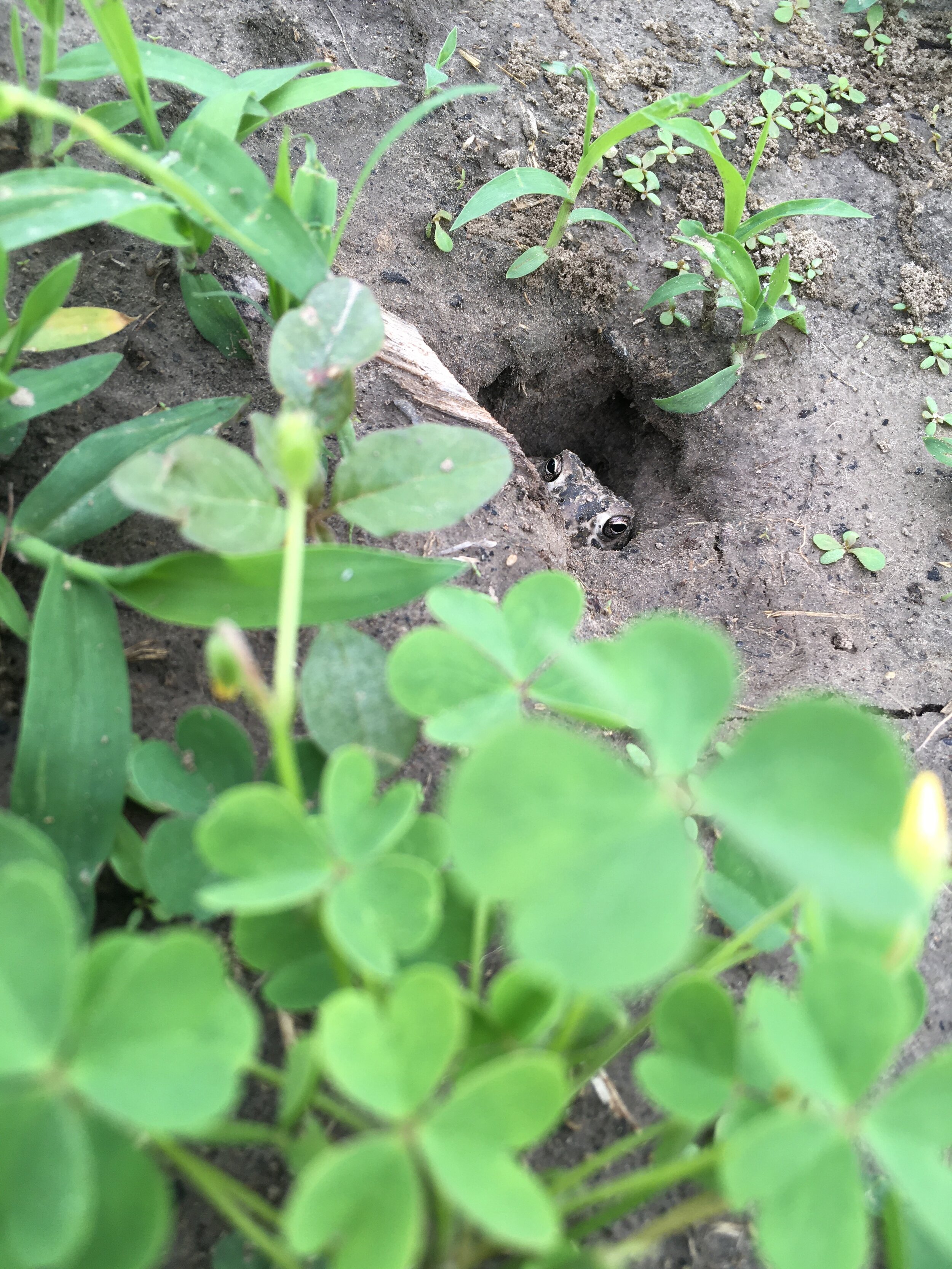Grant Township’s Northeast Sector is arguably Douglas County’s most precious natural resource for keeping people fed.
This project is funded in part by a Natural & Cultural Heritage Open Space Plan grant from the Douglas County Heritage Conservation Council. Funding for the project was approved by the Douglas County Board of County Commissioners on June 14, 2023. Open Space Grant funding was made possible by a sub-grant of the American Rescue Plan Act (ARPA) funding approved by the Board of County Commissioners in 2022.
Meet the Survey Team
Jessi Asmussen, Advisory Board, Mellowfields Farm
Niki Kennniff, Advisory Board, Douglas County Extension Office
Tom Buller, Advisory Board, Kansas Rural Center
Ben Sikes, Advisory Board, University of Kansas
Join us by following along with the team’s curriculum!
Session 1: Liberatory Co-Design & Data Practices
Reading #1 Introduction to Liberatory Design: Liberatory Design is an approach to addressing equity challenges and change efforts in complex systems. It is grounded in an integrated part of National Equity Project’s Leading for Equity Framework, which meshes human-centered design with complex systems theory, and deep equity practice.
Reading #2 CARE Principles: Existing principles within the open data movement (e.g. FAIR: findable, accessible, interoperable, reusable) primarily focus on characteristics of data that facilitate increased data sharing while ignoring power differentials and historical contexts. The CARE Principles for Indigenous Data Governance are people and purpose-oriented, reflecting the crucial role of data in advancing Indigenous innovation and self-determination.
Reading #3 Applying the ‘CARE Principles for Indigenous Data Governance’ to ecology and biodiversity research: Indigenous Peoples are increasingly being sought out for research partnerships that incorporate Indigenous Knowledges into ecology research. Learn how the ‘CARE Principles for Indigenous Data Governance’ can sow community ethics into disciplines that are inundated with extractive helicopter research practices, and we provide standardized practices for evolving data and research landscapes.
Want to share your voice? Once you’ve completed the readings, you can submit responses to the same questions posed to the advisory board here.
The Advisory Board was tasked with answering six central questions. Once answers were in, the team’s responses were compiled into a unified voice.
Question One: Which parts of the system produce equity challenges? Challenges can be adaptive challenges or technical problems. Adaptive challenges are about changing priorities, beliefs, habits and loyalties for the sake of a compelling purpose. Technical problems are where you either know the steps to solve them, or you can depend on someone else to make it happen.
Answer: In examining equity challenges within the agricultural system, several key themes emerge. Access to land presents a significant barrier, particularly for BIPOC individuals, due to the dominance of private ownership and historical inequities in land distribution. Legacy land ownership structures and the capital-intensive nature of traditional food production systems further exacerbate these challenges, as smaller or marginalized farmers often lack the necessary resources and connections to effectively manage land and produce food. The influence of capitalism, with its emphasis on private property rights, perpetuates systemic injustices rooted in the historical theft of land from indigenous peoples. Resolving these equity challenges requires addressing both adaptive challenges, such as changing deeply ingrained beliefs and systems, and technical problems, such as developing reparations models and inclusive survey design processes. Ensuring inclusivity and representation within survey frameworks is essential for capturing diverse agricultural experiences and fostering meaningful change within the agricultural system.
Question Two: What do we need to learn more about as we engage in empathy work (e.g. opportunities to understand the experiences, emotions, and motivations of the person or community engaged in co-design)?
Answer: As we engage in empathy work to understand the experiences, emotions, and motivations of the communities involved in co-design, there are several important aspects we need to learn more about. Firstly, we must consider the time and emotional capacity of the communities we aim to serve, particularly BIPOC communities who may face systemic challenges in making a living. Understanding their daily struggles is crucial for soliciting meaningful input. Secondly, we need to explore how people from diverse backgrounds experience distinct challenges in co-design work and identify obstacles that can be overcome with access to existing resources, as well as those requiring the development of new systems. Thirdly, it's essential to identify and engage interested stakeholders, such as landowners and potential stewards, through creative and inclusive methods such as public discussions. Additionally, we must delve into the motivations of those involved in the survey work and explore whether the survey can serve multiple purposes aligned with these motivations. By addressing these areas, we can ensure that our empathy work is comprehensive and responsive to the needs and aspirations of the communities we seek to empower.
Question Three: In what ways do we envision land transfer and more specifically forms of land transfer that would likely be regarded as unconventional?
Answer: In envisioning unconventional forms of land transfer, several innovative approaches emerge. Firstly, there is the possibility of transferring land to tribal organizations and members, recognizing indigenous sovereignty and addressing historical injustices. Another approach involves large agribusinesses allocating small portions of land to support the development of new and diverse farmers, potentially facilitated by state or county subsidies. Additionally, community-based land tenure options, such as those explored by initiatives like the Agrarian Trust, offer promising avenues for more inclusive and sustainable land management. These efforts experiment with solutions on smaller scales, providing models that can be replicated and scaled up to address systemic challenges. Finally, it's important to recognize the various mechanisms through which land transfer occurs, including inheritance, purchase, gifting, and trading, each with its own implications for ownership and stewardship.
Question Four: In what ways do we anticipate the survey data could influence decision-making processes for farmers, ranchers, and relevant stakeholders?
Answer: The survey data has the potential to significantly influence decision-making processes for farmers, ranchers, and relevant stakeholders in several ways. Firstly, it can provide valuable insights and ideas for continued land stewardship, offering potential avenues for sustainable practices and resource management. Additionally, stakeholders should feel heard and empowered in their unique positions, prompting considerations about who should have access to the data and how it can best serve their needs, whether it be extension agents, private companies, local municipalities, or the broader public. Furthermore, the survey results can inspire and introduce new ideas to landowners, fostering discussions about land use, stewardship, and legacy. By creating a framework for sharing data and insights, the survey has the potential to stimulate collaboration and innovation within the agricultural community, ultimately leading to more informed decision-making and positive outcomes for all stakeholders involved.
Question Five: How can our team actively support the use and reuse of survey data to promote local self-determined development processes and innovation?
Answer: Our team can actively support the use and reuse of survey data to promote local self-determined development processes and innovation in several ways. Firstly, we can ensure that the data is readily accessible and easily available to all interested parties, facilitating its use in decision-making and innovation. Following the FAIR principles—making data Findable, Accessible, Interoperable, and Reusable—can enhance the usefulness of the data by publishing the process, raw (deidentified) data, and models for potential use in larger meta-analyses. Additionally, establishing a publicly facing platform for the survey data can further promote its accessibility and encourage broader engagement with the findings. Furthermore, actively advocating for the adoption of the data in local government communication avenues and long-range planning processes can help ensure its continued impact and relevance in driving local self-determined development and innovation.
Question Six: How could our approach ensure that any value created from the survey data benefits participants in an equitable manner, aligning with community values and contributing to aspirations for wellness?
Answer: Our approach can ensure that any value created from the survey data benefits participants in an equitable manner, aligning with community values and contributing to aspirations for wellness, through several strategies. Firstly, we can incorporate community values directly into the survey and the direction of our approach, actively seeking input from participants on their values and aspirations. This ensures that the survey reflects the priorities and perspectives of the community, and that actions taken based on the survey data are responsive to community needs. Additionally, we can prioritize ongoing engagement with participants, revisiting them often to gather feedback and ensure that their voices continue to shape the process. This approach fosters transparency and accountability, key elements in ensuring equitable outcomes. Furthermore, engaging the public in survey design can enhance the relevance and inclusivity of the survey, ensuring that it reflects diverse perspectives and priorities. Finally, establishing shared goals for the survey design team can help mitigate bias and ensure that the language used in the survey is inclusive and respectful of all experiences. By incorporating these strategies, our approach can effectively harness the value of the survey data to promote equity, community well-being, and positive change.
Collective Response Across All Questions: The collective responses of all respondents underscore a strong commitment to equity, inclusivity, and community-centered approaches in the survey process. There is a shared emphasis on understanding and addressing the needs and challenges faced by marginalized communities, particularly BIPOC individuals, in accessing resources and participating in decision-making processes. Respondents advocate for incorporating community values and perspectives into survey design, ensuring that survey outcomes reflect the priorities and aspirations of the communities served.
Furthermore, there is a recognition of the importance of transparency, accountability, and ongoing engagement with participants throughout the survey process. Respondents highlight the need for making survey data readily accessible and usable, following best practices such as the FAIR principles, and prioritizing ongoing feedback and collaboration to ensure that participant voices shape decision-making processes.
In addition, there is a collective emphasis on innovation, creativity, and experimentation in addressing systemic challenges and promoting positive outcomes. Respondents advocate for exploring unconventional approaches to land transfer, fostering community-based land tenure options, and stimulating discussions and collaborations among stakeholders to drive local self-determined development and innovation.
Overall, the collective synthesis of all respondents' perspectives underscores a holistic and inclusive approach to the survey project, characterized by equity, transparency, community engagement, and innovation. By incorporating these principles and values into the survey process, the team aims to promote positive outcomes and contribute to the well-being and empowerment of all stakeholders involved.
Pantaleon Florez III, Project Co-Lead Maseualkualli Farms
Jackie Keller, Advisory Board, Kansas Rural Center
Robert Hicks Jr, Project Co-Lead Nanasoohannea Farm
Dawn Buehler, Advisory Board, Friends of the Kaw
Project Description
The main goal of this project is to gather community input in conjunction the Open Space Plan on agricultural land use, stewardship practices, needs of farmers/ranchers, long-term farm and ranch planning, alternative land transfer methods, and conservation efforts on agriculturally and farmstead zoned parcels within the 8-mile stretch of the Kaw River where Douglas County borders both the northern and southern banks. In addition to survey development, distribution, and analysis; this project will assemble an advisory board consisting of agricultural producers, land advocates, and scientists. To hone further in on the under told stories of farmers/ranchers in this floodplain, the project will conduct interviews with surveyed farmers/ranchers to contribute to the storytelling components of the Open Space Plan’s Community Visioning. The surveys created within this project will be open sourced and are intended to assist the County Heritage Office with further surveying of ecologically sensitive agriculturally zoned lands. Public access will come in the form of social media presence, a website, and four community engagement events.


